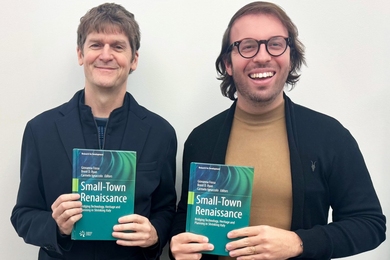MIT artificial intelligence researcher Thomas F. Knight wants to be able to program a living cell the way he would program a computer.
A senior research scientist in electrical engineering and computer science, Dr. Knight doesn't think this idea is far-fetched. From an engineering standpoint, he said, living cells are already amazing machines. They reproduce themselves, are energy-efficient and waste-efficient, can process chemicals, and can sense stimuli such as light, heat and acidity. They can move and fluoresce. Their DNA stores and replicates one megabit of information. "This is way, way, way denser than any form of silicon technology," he noted. Research and industry already are trying to take advantage of some of these features by employing biological tools to manufacture non-biological devices.
Dr. Knight is working to develop novel computing structures from living biological cells. He spoke to a group of alumni/ae inventors and entrepreneurs, venture capitalists, business leaders, and Institute faculty and staff at the Resource Development-sponsored Technology Breakfast Series on October 25.
"A natural cell is already doing computation," he said. "They already figure out where the food is and what environment they are in, and adapt their behavior to those environments. The whole trick is to learn from what the natural world is providing, take those techniques and turn them to our own purposes."
Those purposes may be monitoring glucose levels in diabetics, growing crops that you can inform about a coming drought, or instructing flowers to count the days until Valentine's Day so they bloom on the right day.
DNA already is "digital" -- the bases that make up the genetic code are four distinct entities.
"If we want to build digital behavior in living cells, we can replicate ones and zeroes as the presence or absence of specific DNA binding proteins," Dr. Knight said. The binding protein would be used to control which genes are expressed or inhibited, creating outputs of one or zero.
Using this method, researchers can design a "NAND" gate. A logic gate equivalent to an "AND" gate followed by a "NOT" gate, NAND gates are important because all Boolean logic operations can be built out of them. With these components, "we now have a universal mechanism able to create any kind of computational mechanism," he said. "It's all downhill from here."
To find a cell that he can manipulate in this manner, Dr. Knight is working on finding and then tailoring the simplest living system possible. He has identified a plant and insect pathogen that may be the ideal candidate. The simplest bacterium known, it has only 454 genes, compared with the thousands owned by its more complex cousin, E. coli. Researchers have shown that it may be possible to pare those down to around 293 essential genes.
While there is still much ground that needs to be covered before researchers can completely fabricate, design and control a living cell, "300 is a doable number," Dr. Knight said. From an engineering viewpoint, this is not an intractable system."
A version of this article appeared in MIT Tech Talk on November 1, 2000.





